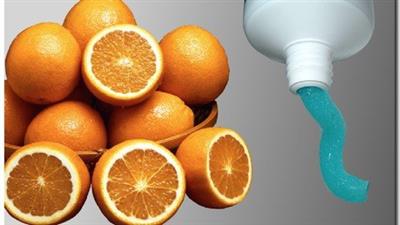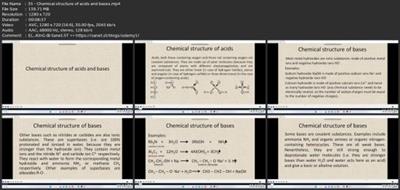O
0

Published 12/2022
MP4 | Video: h264, 1280x720 | Audio: AAC, 44.1 KHz
Language: English | Size: 3.48 GB | Duration: 7h 58m
Periodic properties of elements, chemical bonds (ionic and covalent), redox reactions for GCSE and A-level
MP4 | Video: h264, 1280x720 | Audio: AAC, 44.1 KHz
Language: English | Size: 3.48 GB | Duration: 7h 58m
Periodic properties of elements, chemical bonds (ionic and covalent), redox reactions for GCSE and A-level
What you'll learn
Properties of atoms and how they vary in the periodic table
Structure of the atom and periodic table
Bonds between atoms - chemical bonds - ionic bond
Bonds between atoms - chemical bonds - covalent bond
Chemical reactions and redox reactions
Defining acids and bases and their classification
The Bronsted-Lowry protolytic theory of acids and bases
Defining pH, pH calculation formula and the pH determination of solutions
Chemical reactions of acids and bases
Solved exercises, problems and questions with acids and bases at GCSE level
Solved exercises, problems and questions with acids and bases and periodic table for International Baccalaureate (IB)
Requirements
Knowledge about the structure of matter and what an atom is at grades 7-8 or Key Stage 3 (KS3) level
Knowledge about the classification of substances at grades 7-8 or Key Stage 3 (KS3) level
Knowledge about Mendeleev's periodic table at grades 7-8 or Key Stage 3 (KS3) level
Description
All you need to know about acids, bases and pH for GCSE and A-level. This course includes the definitions of acids and bases in terms of their chemical behavior. At the end of the course you should be familiar with:1. What acids and bases are in terms of their chemical behaviour2. The chemical and molecular mechanisms of acidity and basicity3. Which chemical species are acids and which are bases and how chemical bonding determines whether a molecule is an acid or a base 4. What pH is, its relevance in chemistry and in everyday life and how to calculate the pH of any solution of acid or base by knowing the nature of the acid/base and its concentration. Two important theories have been proposed to qualify a substance as an acid or a base. These are the proton-transfer Bronsted-Lowry theory and the electron-pair-transfer Lewis theory. According to the proton-transfer theory, an acid is a chemical entity (molecule, ion or radical) capable of donating on or more protons (hydrogen ions H+) and a base is a chemical entity (molecule, ion or radical) capable of accepting one or more protons. According to the Lewis theory, an acid is a chemical entity capable of accepting a pair of electrons, while a base is a chemical species capable of donating a pair of electrons. Note that all Bronsted bases are also Lewis bases, but not all Bronsted acids are also Lewis acids. This course offers an insight in the structure and organization of the periodic table of elements and how the physical and chemical properties of the chemical elements vary in the periodic table (the law of periodicity). All concepts needed (such as electronegativity or valence/oxidation number) are explained and discussed in detail before the concepts of acid and base and pH are introduced. This is in order to ensure a complete and an in-depth understanding of what acids and bases are and how they work and why they do work in the way they do. The course also offer an in-depth analysis of how chemical bonds are formed and their properties in order to understand how acids and bases work.This course also introduces the notion of pH, which is the negative decimal logarithm of the molar concentration of the H+ ions in a solution. pH is basically the power (or the exponent) of 10 with the reverted sign from the molar concentration of hydrogen ions. Please get used to writing a small 'p' next to a capital 'H' when writing down this parameter. pH is widely used in everyday life in order to determine acidity or basicity of a solution, from household solutions such as vinegar or bleach to industrial or laboratory solutions. pH is also very important in biological systems (living organisms) since the reactions which determine and sustain life are strongly pH-dependent. The pH scale most often runs from 0 to 14, where 7 is neutral (e.g. pure or distilled water). A pH value less than 7 indicates an acidic solution, while a pH value greater than 7 indicates a basic (or alkaline) solution. Note that the pH scale is a decimal logarithmic scale (and not a linear scale) and each unit is 10 times more or less acidic/basic than the previous/next one (depending in which direction you are going). Thus, a solution with a pH of 3 is not two times more acidic than a solution with a pH of 6, but a thousand times more acidic (or 10 to the power of 3, since 6-3 = 3). The pH scale in the 0 to 14 format is used for dilute solutions (up to 1 mole/liter strong acid or strong base). Concentrated solutions of strong acids or strong bases would have a pH value less than 0 or greater than 14 respectively. For instance, a solution containing 10 moles of strong acid dissolved in one liter of water would have a pH value of -1 and a solution containing 10 moles of strong base dissolved in one liter of water would have a pH value of 15. Due to solubility reasons, a pH value of less than -2 or greater than 16 could not be achieved, since the aforementioned values already involve several kilograms of substance dissolved in just one liter of water. Consequently a pH value of -3 and 17 would involve several tens of kilograms of substance dissolved in just one kilogram of water, which is theoretically impossible, even for the most soluble substances.Last, but not least, the course provides 11 solved GCSE quizzes about acids and bases and 19 solved GCSE quizzes about periodic table and bonding. Additionally, 6 solved A-level quizzes on acids an bases are provided.
Overview
Section 1: Periodic properties of elements - part I atomic radius, atomic volume
Lecture 1 Periodic properties of elements- part I atomic radius, atomic volume
Section 2: Periodic properties of elements - part II - electronegativity, electron affinity
Lecture 2 Periodic properties of elements - part II - electronegativity, electron affinity
Section 3: Periodic properties of elements - part III - chemical properties
Lecture 3 Periodic properties of elements - part III - chemical properties
Lecture 4 Periodic properties of elements - part III.2 - corrosion and fermentation
Section 4: How chemical bonds are formed - part I ionic bond
Lecture 5 How chemical bonds are formed - Part I - Ionic bond
Section 5: How chemical bonds are formed - part II - covalent bond
Lecture 6 How chemical bonds are formed - Part II - Covalent bond
Section 6: Periodic table and bonding - solved GCSE questions
Lecture 7 Periodic table quiz footprints science
Lecture 8 Periodic table 2 quiz footprints science
Lecture 9 Periodicity, atomic and ionic radii, atomic models quiz
Lecture 10 Grade gorilla - The periodic table quiz
Lecture 11 Group 1 quiz footprints science
Lecture 12 Alkaline earth metals quiz
Lecture 13 Group 7 quiz footprints science
Lecture 14 Group VII the halogens quiz
Lecture 15 Group 0 noble gases quiz
Lecture 16 Chemical bonds quiz footprints science
Lecture 17 Forming ions quiz footprints science
Lecture 18 Ionic compounds
Lecture 19 Formation of sodium oxide quiz
Lecture 20 Covalent bonding quiz footprints science
Lecture 21 Grade Gorilla - Bonding quiz
Lecture 22 Grade gorilla properties quiz
Lecture 23 Alkali metals quiz
Lecture 24 The periodic table IV family names
Lecture 25 Chemical bonding I Ionic bonding
Lecture 26 Ionic bonding II nomenclature
Lecture 27 Ionic bonding III practice
Lecture 28 Halogens quiz answers
Lecture 29 Covalent bonding I quiz answers
Lecture 30 Grade Gorilla - Chemistry IB periodic table quiz
Lecture 31 Grade Gorilla - Chemistry IB ionic bonding
Section 7: Chemical reactions - redox reactions
Lecture 32 Chemical reactions - redox reactions
Section 8: Definition and classification of acids and bases
Lecture 33 Definition and classification of acids and bases
Section 9: The pH scale
Lecture 34 The pH scale
Section 10: Chemical structure of acids and bases
Lecture 35 Chemical structure of acids and bases
Section 11: How do acids make a solution acidic and how do bases make a solution basic
Lecture 36 Dissociation of acids in water
Lecture 37 How the strength of an acid varies in the periodic table
Lecture 38 Quantifying the strength of an acid - the acidity constant
Lecture 39 What is a base - definition of bases
Lecture 40 Ionization of bases in water
Lecture 41 Quantifying the strength of a base - basicity constant
Section 12: Acid-base interchanges- conjugate bases and conjugate acids
Lecture 42 Acid-base conjugate pairs
Section 13: How to precisely calculate the pH of a solution of an acid or a base
Lecture 43 How to determine the pH of a solution of an acid
Section 14: How does water allow itself becoming acidic or basic-the ionic product of water
Lecture 44 The ionic product of water
Section 15: Chemical properties of acids and bases
Lecture 45 Chemical properties of acids and bases
Section 16: Solved GCSE quizzes on acids and bases
Lecture 46 Grade Gorilla Acids + Bases quiz
Lecture 47 Acids, Bases, Salts and pH quiz
Lecture 48 Acids, bases and pH quiz
Lecture 49 Acids, alkalis and salts test questions AQA
Lecture 50 Acids and alkalis quiz footprints science
Lecture 51 Acid or base quiz footprints science
Lecture 52 Indicators quiz footprints science
Lecture 53 Neutralization quiz footprints science
Lecture 54 Strong and weak acids quiz footprints science
Lecture 55 GCSE Chemistry Acids, Bases and Salts
Lecture 56 GCSE quizzes acids and alkalis
Section 17: Solved A-level quizzes on acids and bases
Lecture 57 pH calculation quiz footprints science
Lecture 58 More pH calculations footprints science
Lecture 59 pH of weak acids quiz footprints science
Lecture 60 Acids and Bases: An introduction
Lecture 61 Quiz: Introduction to acids and bases
Lecture 62 The pH scale quiz
Parents and guardians of GCSE and A-level students,Parents and guardians of pupils aged 16-18

Download link
rapidgator.net:
You must reply in thread to view hidden text.
uploadgig.com:
You must reply in thread to view hidden text.
nitroflare.com:
You must reply in thread to view hidden text.
1dl.net:
You must reply in thread to view hidden text.

